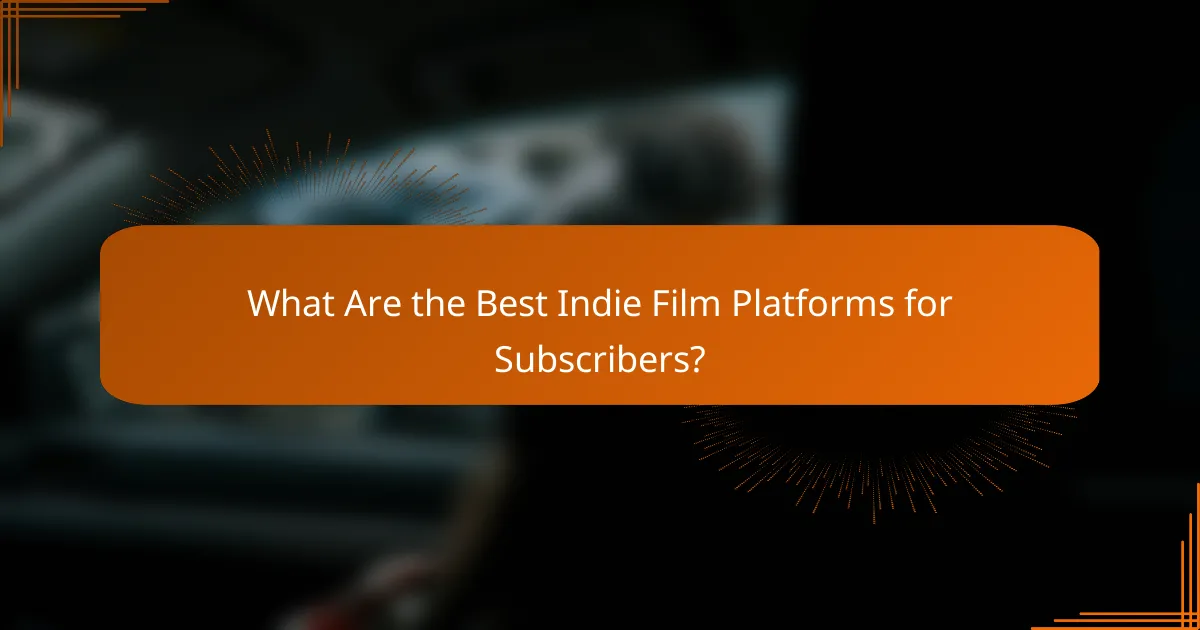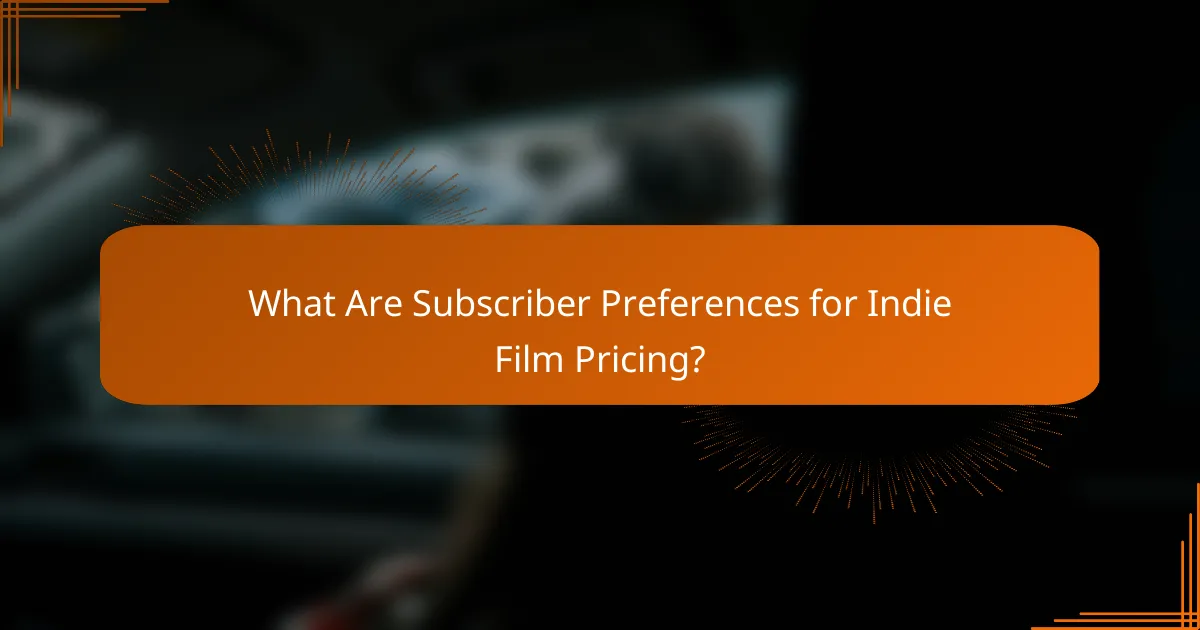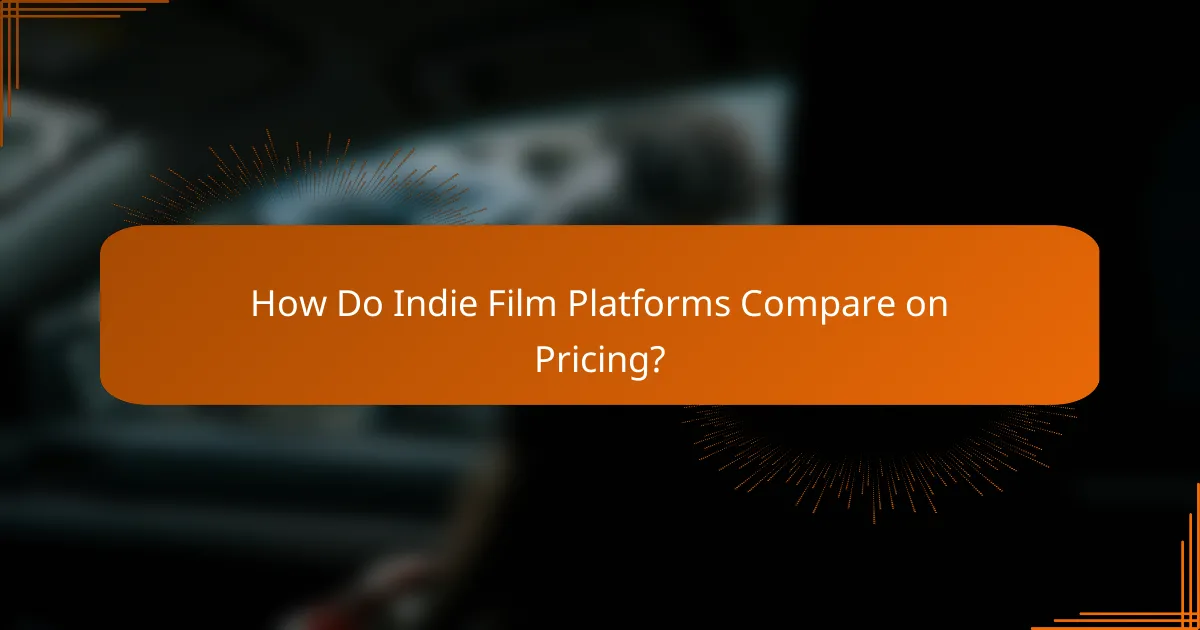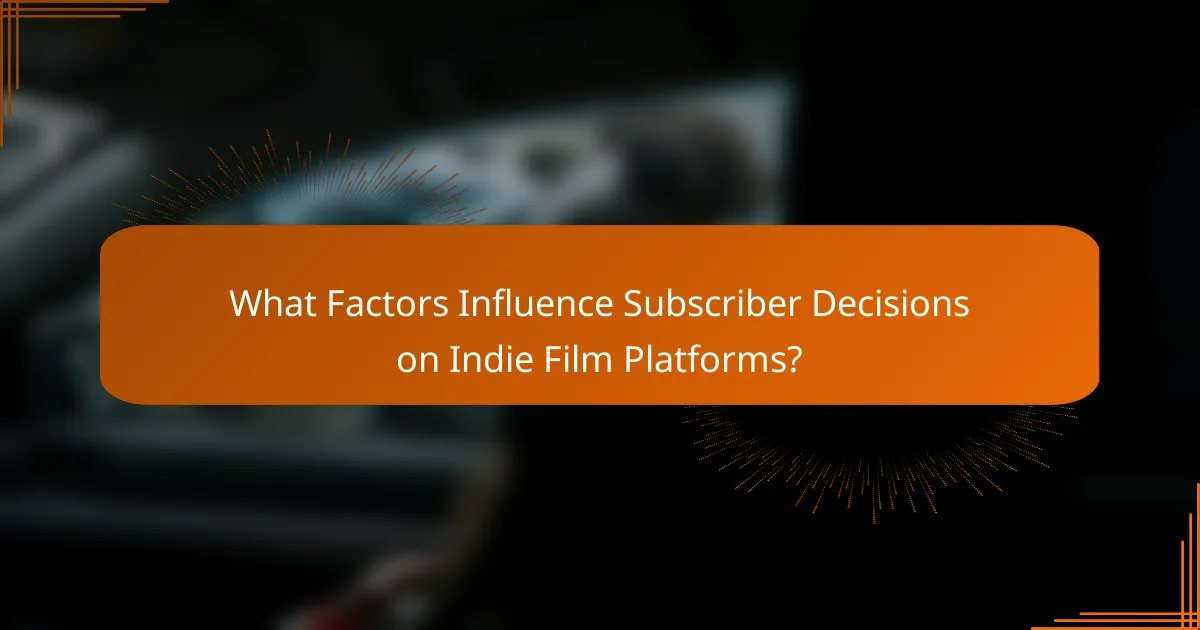Indie film platforms provide unique content and flexible pricing models that cater to both independent filmmakers and audiences seeking diverse cinematic experiences. By understanding subscriber preferences for value, content variety, and exclusive access, these platforms can effectively tailor their offerings to enhance audience satisfaction and retention.

What Are the Best Indie Film Platforms for Subscribers?
The best indie film platforms for subscribers offer unique content, flexible pricing models, and varying levels of access. These platforms cater to independent filmmakers and audiences seeking diverse cinematic experiences.
Vimeo OTT
Vimeo OTT allows creators to launch their own subscription video-on-demand services. With customizable pricing, filmmakers can set monthly or yearly fees, providing flexibility in monetization. The platform charges a percentage of revenue, so it’s essential to consider this when pricing your content.
Creators can also leverage Vimeo’s extensive analytics to understand subscriber behavior and adjust their offerings accordingly. This data-driven approach helps in optimizing content and pricing strategies.
FilmFreeway
FilmFreeway primarily serves as a submission platform for film festivals but also offers a marketplace for indie films. While it does not have a direct subscription model, filmmakers can showcase their work and attract subscribers through festival exposure. This can lead to potential distribution deals or direct sales.
Consider using FilmFreeway to gain visibility and connect with audiences who are passionate about indie films. Engaging with festival audiences can create a loyal subscriber base for future projects.
IndieFlix
IndieFlix operates on a subscription model, providing access to a vast library of independent films. Subscribers pay a monthly fee for unlimited viewing, making it an attractive option for film enthusiasts. The platform also supports filmmakers by offering a revenue-sharing model based on viewership.
Filmmakers should focus on creating high-quality content that resonates with the IndieFlix audience to maximize their earnings. Regularly promoting new releases can help maintain subscriber interest and engagement.
Seed&Spark
Seed&Spark combines crowdfunding with a streaming service, allowing filmmakers to raise funds and distribute their films. Subscribers can support projects directly and gain access to exclusive content. This model fosters a community-driven approach to indie filmmaking.
Filmmakers should actively engage with their audience through updates and behind-the-scenes content to build a strong subscriber base. Offering incentives for early supporters can also enhance funding efforts.
Amazon Prime Video Direct
Amazon Prime Video Direct enables filmmakers to distribute their content on one of the largest streaming platforms. Creators can choose between a pay-per-view or subscription model, allowing flexibility in pricing strategies. Earnings are based on views, which can vary significantly depending on content popularity.
To succeed on this platform, filmmakers should focus on marketing their films effectively and optimizing their listings. Utilizing Amazon’s promotional tools can help increase visibility and attract more subscribers.

How Do Pricing Models Vary Across Indie Film Platforms?
Indie film platforms utilize a range of pricing models to cater to diverse audience preferences and revenue strategies. Understanding these models can help filmmakers and distributors choose the best approach for their content and target market.
Subscription-based pricing
Subscription-based pricing allows users to access a library of films for a recurring fee, typically charged monthly or annually. This model is popular among platforms like Netflix and Hulu, where subscribers enjoy unlimited viewing of available titles.
For indie films, platforms may charge between $5 to $15 per month, offering a steady revenue stream. Filmmakers should consider the potential for higher viewer engagement, as subscribers are more likely to explore various films within the platform’s catalog.
Pay-per-view pricing
Pay-per-view pricing requires users to pay for each film they wish to watch, often at a set price per rental or purchase. This model is common on platforms like Vimeo On Demand and Amazon Video, where viewers can choose specific titles without a subscription commitment.
Prices for indie films in this model typically range from $2 to $10 per rental, with purchase options often higher. This approach can be beneficial for niche films that may not attract a broad audience, allowing filmmakers to monetize individual viewings effectively.
Ad-supported models
Ad-supported models provide free access to films while generating revenue through advertisements. Platforms like Tubi and Crackle utilize this approach, allowing viewers to watch content without a subscription fee.
While this model can attract a larger audience due to its no-cost entry, filmmakers may earn less per view compared to subscription or pay-per-view models. It’s crucial to balance ad frequency with viewer experience to maintain engagement.
Hybrid pricing structures
Hybrid pricing structures combine elements of subscription, pay-per-view, and ad-supported models to maximize revenue opportunities. For instance, platforms may offer a subscription tier with ad-free viewing alongside a pay-per-view option for new releases.
This flexibility can cater to different audience segments, allowing users to choose how they want to access content. Filmmakers should evaluate their target audience’s preferences to determine if a hybrid model could enhance their film’s reach and profitability.

What Are Subscriber Preferences for Indie Film Pricing?
Subscribers to indie film platforms typically prioritize value for money, content variety, and exclusive access when considering pricing models. Understanding these preferences can help platforms tailor their offerings to meet audience expectations and enhance subscriber retention.
Value for money
Value for money is a critical factor for subscribers of indie film platforms. Many users expect a diverse selection of films for a reasonable monthly fee, often in the range of $5 to $15. Platforms that offer competitive pricing while maintaining a quality library are more likely to attract and retain subscribers.
To enhance perceived value, platforms can consider bundling services or offering discounts for annual subscriptions. This approach not only incentivizes longer commitments but also provides subscribers with a sense of savings.
Content variety
Content variety is essential for keeping subscribers engaged. Users are drawn to platforms that offer a mix of genres, including drama, documentary, and experimental films. A well-curated selection that rotates regularly can keep the content fresh and appealing.
Platforms should aim to include both popular indie titles and hidden gems to cater to diverse tastes. Regularly updating the library and highlighting new releases can enhance subscriber satisfaction and encourage ongoing subscriptions.
Exclusive access
Exclusive access to films or behind-the-scenes content can be a significant draw for subscribers. Many users appreciate the opportunity to view premieres or special features not available on other platforms. This exclusivity can justify a higher price point for some subscribers.
Offering members-only screenings, Q&A sessions with filmmakers, or early access to new releases can create a sense of community and loyalty among subscribers. Platforms should communicate these exclusive benefits clearly to attract new users and retain existing ones.

How Do Indie Film Platforms Compare on Pricing?
Indie film platforms vary significantly in their pricing models, which can impact filmmakers’ revenue and audience reach. Understanding these differences is crucial for creators looking to choose the right platform for their projects.
Vimeo OTT vs. Seed&Spark
Vimeo OTT offers a subscription-based model where creators can set their own pricing, typically ranging from $5 to $15 per month for viewers. This flexibility allows filmmakers to cater to their audience’s willingness to pay, but they must also manage the platform’s 10% revenue share.
In contrast, Seed&Spark operates on a crowdfunding model, allowing filmmakers to raise funds before production. While there are no upfront costs, creators must incentivize backers with rewards, which can complicate the pricing strategy. The platform takes a 5% fee on successful campaigns, making it a more cost-effective option for funding indie projects.
IndieFlix vs. Amazon Prime Video Direct
IndieFlix uses a subscription model where viewers pay around $5 per month, with filmmakers receiving a share based on viewership. This model encourages creators to promote their films actively, as higher views translate to better revenue.
Amazon Prime Video Direct, however, allows filmmakers to choose between a pay-per-view or subscription model. Creators can earn royalties based on the number of hours watched, but they must navigate Amazon’s complex payment structure, which can be less favorable for indie filmmakers. Understanding these nuances is essential for maximizing earnings on the platform.

What Factors Influence Subscriber Decisions on Indie Film Platforms?
Subscriber decisions on indie film platforms are primarily influenced by content quality and user experience. These factors determine not only the appeal of the platform but also its perceived value and overall satisfaction among users.
Content quality
Content quality is crucial for attracting and retaining subscribers on indie film platforms. High-quality films that offer unique storytelling, engaging performances, and professional production values tend to draw more viewers. Platforms that curate their selections carefully, focusing on originality and artistic merit, often see higher subscription rates.
Subscribers are likely to compare the range of content available, including genres, themes, and exclusivity. For instance, platforms that feature award-winning films or critically acclaimed indie projects can justify higher subscription fees. Offering a mix of established and emerging filmmakers can also enhance the perceived value.
User experience
User experience plays a significant role in subscriber retention on indie film platforms. A seamless interface, easy navigation, and responsive design can significantly enhance viewer satisfaction. Platforms that prioritize user-friendly features, such as personalized recommendations and simple search functions, are more likely to keep subscribers engaged.
Moreover, factors like streaming quality, loading times, and device compatibility are essential. Users expect high-definition streaming with minimal buffering. Platforms that provide a smooth viewing experience across various devices, including smart TVs, tablets, and smartphones, tend to foster loyalty among their subscribers.


